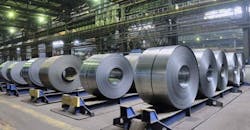For Manufacturers, the Devil is in the Details on Steel, Aluminum Tariffs
U.S. manufacturing executives concerned about recently announced steel and aluminum tariffs may yet be able to take action to minimize the impact these trade actions could have on their bottom line.
President Donald Trump has announced tariffs on imported steel at 25% and aluminum imports at 10% that go into effect after March 23. Trump has initially exempted Mexico and Canada from the tariffs as Washington seeks to renegotiate the North American Free Trade Agreement (NAFTA). However, if those NAFTA exemptions are made permanent, the tariffs on products from other countries may be hiked above 25%, insiders say.
The Trump administration wants to reduce the U.S. trade deficit and to boost aluminum production, now below 50% of capacity, to above 80% and to boost steel production to a similar level from about 70% of capacity utilization today.
However, even in the first few days after the tariffs were announced on March, changes and exemptions have been made. That suggests that much of the finer details of the tariffs will remain in flux and could be changed before March 23, and even beyond as industry players argue for their interests.
As a result, businesses that import steel and aluminum, from automakers to canning companies, should take some immediate steps to ensure the best outcome.
---Manufacturing executives should undertake a systematic supply-chain review. Many companies that buy from U.S. wholesalers may think they’re purchasing domestic steel or aluminum when in fact that inventory is sourced overseas and just cut, shaped and delivered by a U.S. distributor. And, even if the country where the materials are sourced is subject to tariffs, not all types of these metals are impacted. To know exactly what will be taxed, executives should review Harmonized Tariff Schedule codes —10-digit identifiers that specify the precise type of steel and aluminum being taxed. Right now, that’s a moving target, with fewer steel products than aluminum materials listed. For example, certain grades of stainless steel are exempted.
--If a company learns that the steel or aluminum it uses will be taxed, it should quickly explore other options. For some, the simplest move may be to source U.S.-manufactured materials instead of imported metals. However, even if U.S. steel can be sourced, those prices will rise once the tariffs take effect, reflecting the shift to the supply-demand curve.
--Companies can also seek exemptions if the material they want to import can’t be sourced at a reasonable cost domestically, or if there is a national security interest for the exemption. The U.S. Commerce Department has yet to announce the precise procedure for seeking exemptions. However, such applications are typically onerous, so many middle-market companies may need assistance from their trade advisors or lawyers. Alternatively, companies could request their customs broker to seek an exemption.
History suggests the tariffs could be short-lived. In 2002, the Bush administration put a 30% tariff on imported steel, but scrapped the penalty 20 months later after Europe and others threatened retaliation. Experts say the lesson from that episode is that while protectionism helps producers, it harms manufacturers that buy steel.
Some fear the tariffs could spark a broader trade war. China, for example, could retaliate by acting against U.S. soybean exports. Last year, China bought the vast majority of U.S. production — importing $13.9 billion worth of U.S. soybeans. After the U.S. slapped tariffs on solar panels and washing machines, China is considering whether to restrict American access to China’s soybean market in retaliation.
However, like other important connections in an increasingly global economy, the U.S.-China partnership is symbiotic: The United States needs China to buy soybeans, and Beijing needs that supply to make pig feed to sustain its vital pork industry.
There are reasons to think that these trade tensions may de-escalate, not least because Trump exempted NAFTA partners from the tariffs. That suggests these tariffs might not be the start of a trade war but could be a dramatic marker being used by Washington as a sign that it wants to reset key U.S. trade relationships in order to reduce the trade deficit. Trump has already made clear he wants to dramatically reshape NAFTA, and since the tariffs were announced, South Korea has signaled it wants to negotiate an exemption as well.
While all this plays out, manufacturers should pay attention and stay close to developments to ensure that any negative impact these tariffs have on their bottom line is minimized.
Lou Longo is the international consulting practice leader at Plante Moran.
